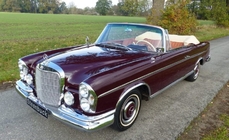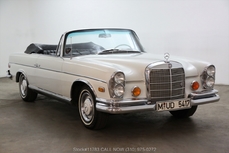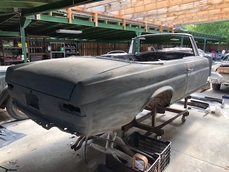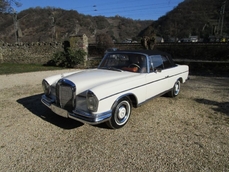Mercedes-Benz 300SE Cabriolet w112 1967
Allgemeine Beschreibung :
Mercedes-Benz was undergoing a dramatic transformation in the late 1950s. With their post-war recovery efforts essentially complete, they began to streamline their product line through platform sharing; taking advantage of the economies of scale they enjoyed as one of the world’s largest automakers. The passenger car line was led by the ageing 300 “Adenauer” series; large, body-on-frame limousines, coupes and cabriolets that were expensive and time consuming to manufacture. With the 600 “Grosser” still a few years away, a new and modern flagship was needed. Utilizing the existing W111 platform, Mercedes stuffed the Adenauer’s (also shared with the 300 S and SC) M189 3.0 liter, all-alloy inline-six under the bonnet, added luxurious trimmings and updated the chassis with a sophisticated air-ride suspension system. The changes were enough to necessitate a new internal designation: W112. The W112 300 SE debuted in 1961, available only as the four-door “Heckflosse” (fin-tail) saloon. In 1962, it was joined by the restyled 2-door coupe and cabriolet. The 2-door cars were very modern and elegant, eschewing the sharp fins of the saloon for a more subtly rounded treatment on the rear quarters. The revised styling was the work of the great master Paul Bracq, who had become head of Sindelfingen, Mercedes’ spiritual design center, in 1959. Bracq’s freshened design was so well-received that it inspired both the W111 saloon’s replacement (W108), and carried over when the W112 was replaced by the conventionally sprung W111 2-door.
Despite its shared-platform roots, the W112 was still a very prestigious and expensive car. When the 2-door coupe was first shown on the 1961 auto show circuit, the list price was twice that of another new grand touring car that debuted the same year: Jaguar’s E-Type. 300 SE Coupes and Cabriolets were intended for the most discerning of buyer; those who valued luxury, understated style and exceptional quality. Due to their high cost and hand-assembled construction, very few found buyers, with just 3,127 combined coupes and cabriolets sold through the end of 1967.
This handsome 1967 300 SE Cabriolet is a very desirable example from the final year of W112 production. Presented in the very attractive color combination of Weissgrau (White-Gray, code 158) over a fresh dark green leather interior and a dark green top, it is one of just 708 W112 Cabriolets produced from 1962-1967. The subtle light gray paintwork suits the elegant Paul Bracq-designed body and it is correctly adorned with chrome wheel arch and body side moldings that distinguish the 300 SE from its lower-spec brethren. The body is straight, with factory-precise fitment of the doors and deck lids. A recent bare-metal respray in the correct original color (per the trim tag) presents in excellent condition, with deep gloss and straight reflections. Doors shut with the satisfying solidity of a 60’s era Mercedes-Benz, and the fitment of the trim is very good. Bumpers are straight, with nice quality plating, while the remaining bright trim is tidy and smart, with some restoration work being done as needed at the time of the respray. The original steel wheels have been repainted in body color, adorned with color-keyed two-piece wheel covers as correct. This is a handsome and understated automobile; a refined, sophisticated interpretation of Mid-Century Modern design.
A highlight of this car has to be the wonderful, freshly-restored green leather interior which stands out brilliantly against the light gray paintwork. Taut, fresh upholstery on the front and rear seats is done in the period correct pattern and colors. Interior panels have also been carefully restored and the floors are correctly lined in green-gray square weave carpeting, bound in matching green leather. It is a wonderful yet seldom seen combination that suits the car brilliantly. In addition to the new upholstery, the typically fragile woodwork has been fully restored by the experts at Madera Concepts with stunning results. Fitted with original instrumentation, the original VDO clock, a period correct Becker Europa stereo and a factory Kuhlmeister air conditioning unit; the dash presents beautifully, particularly with its renewed woodwork. Literally topping off the fabulous new interior is a lovely, fully lined convertible top in dark green German canvas which has been expertly fitted and remains taut and free of creases. A top boot in matching green leather is included to keep a sleek look when the roof is folded. The trunk is correctly detailed with a factory original gray rubber mat, and a set of original tools is included in the factory-supplied tool roll.
Mechanically, this 300 SE is in excellent order. Showing approximately 60,000 miles, it sits proud on the original air suspension, with a tidy, well-presented undercarriage and engine bay. As a later production W112, this car’s fuel injected, 3.0 liter, M189 inline six-cylinder engine produces 170 horsepower (ten more than the earlier cars) and sends its power through a column-shifted Mercedes-Benz four-speed automatic transmission. The engine is very well detailed and tidy, showing recent service. It runs well, delivering strong performance and exquisite ride quality thanks to that sophisticated pneumatic ride control.
A true flagship Mercedes-Benz, the W112 300 SE was a beautifully engineered and meticulously hand-built luxury grand touring car that was designed to appeal to only the most discriminating buyers. The rarity and exceptional quality of this fine car makes it highly sought after by today’s collectors, while the advanced engineering and exquisite build quality makes it an exceptional driver’s car, ideally suited for tours and rallies the world over. Much has been spent on this highly desirable 300 SE to ensure it is a beautiful and thoroughly usable example that can keep up to the demands of its next owner.
https://hymanltd.com/vehicles/5613
1967 Mercedes-Benz 300SE Cabriolet w112 is listed verkauft on ClassicDigest in St. Louis by Mark Hyman for $269500.
Fakten der Auto
Karosserietyp : Auto Marke : Mercedes-Benz Modell : 300SE Cabriolet w112 Hubraum : 0.0 Modelljahr : 1967 Karosstyp : Convertible Lage : Missouri
Verkauft
Angaben Zum Verkäufer
Verkauft
People who viewed this Mercedes-Benz 300SE Cabriolet w112 also viewed similar Mercedes-Benz listed at ClassicDigest
Other cars listed for sale by this dealer
über Mercedes-Benz
In den Annalen der Automobilgeschichte entfaltet sich die Reise von Mercedes-Benz wie eine Erzählung voller Ingeniosität seiner Gründer. Im Jahr 1886 schuf Karl Benz den Benz Patent Motorwagen, eine Kreation, die als das weltweit erste Automobil in die Geschichte eingehen sollte. Unwissentlich markierte dieser Moment den Ursprung dessen, was sich zu einem weltweit renommierten Premium-Autohersteller entwickeln würde. Die finanzielle Basis dieses bahnbrechenden Unternehmens wurde interessanterweise von Karls Ehefrau, Bertha Benz, bereitgestellt, was eine bemerkenswerte Partnerschaft demonstrierte, die den Ton für das Erbe von Mercedes-Benz setzen sollte.Nicht weit entfernt entstand eine parallele Erzählung, als die Daimler-Motoren-Gesellschaft, gegründet von Gottlieb Daimler und Wilhelm Maybach, die Bühne betrat. Im Jahr 1901 enthüllten sie ihr Auto unter dem mittlerweile berühmten Namen "Mercedes", was auf Spanisch "Geschenk Gottes" bedeutet. Dieser Name wurde auf das Auto auf Wunsch von Emil Jellineks Tochter verliehen, dem Vertriebspartner der Daimler-Motoren-Gesellschaft. Die Räder der Innovation wurden in Bewegung gesetzt.
Springen wir vorwärts ins Jahr 1926, ein entscheidendes Jahr, das die Fusion von Daimler mit Benz & Cie. sah, was zur Geburt von Daimler-Benz führte. Die Fusion führte zur Übernahme von "Mercedes-Benz" als das renommierte Markenzeichen für ihre Automobile und verschmolz die Legenden zweier visionärer Unternehmen zu einer.
Entgegen konservativen Wahrnehmungen entfaltet sich die Geschichte von Daimler-Benz als Chronik von Branchenneuheiten. Von der Einführung des Wabenkühlers über den Schwimmervergaser bis zur bahnbrechenden Einführung von Vierradbremsen im Jahr 1924 trieb Daimler-Benz kontinuierlich die Grenzen der automobilen Innovation voran. Der Dieselantrieb des Mercedes-Benz 260 D im Jahr 1936 markierte den Beginn von Dieselmotoren in Personenkraftwagen. Der ikonische Mercedes-Benz 300SL Gullwing schrieb Geschichte als das erste Auto mit direkter Kraftstoffeinspritzung, wenn auch der winzige 2-Takt-Motor des Gutbrod Vorrang beanspruchen kann.
Sicherheitsinnovationen wurden zum Markenzeichen, mit Béla Barényis patentiertem Sicherheitszellen-Design in den "Ponton"-Modellen im Jahr 1951, das Front- und Heck-Knautschzonen umfasste. Der W116 450SEL 6.9 führte die Einführung des Antiblockiersystems (ABS) ein, eine weitere wegweisende Sicherheitsfunktion. Vom ersten serienmäßigen Airbag bis hin zu vielen weiteren Innovationen wurde das Erbe der "Ersten" weiter in das Gewebe von Daimler-Benz eingeschrieben.
Auf seiner über hundertjährigen Reise hat Mercedes-Benz nicht nur Autos produziert, sondern automobile Ikonen geschaffen. Der SSKL, 710 SSK Trossi Roadster, 770K Grosser, 540K Spezial Roadster, 300SL Gullwing, W100 600 Pullman, W111 280SE 3.5 Flachkühler, W113 230SL Pagode, W109 300 SEL 6.3 und W201 2.3-16 Cosworth sind Zeugnisse des Engagements der Marke für Ingenieurkunst.
Die donnernden Silberpfeile, oder "Silberpfeile", darunter der W 25, W 125, W154, W165 und W196, schufen ein Erbe der Dominanz auf der Rennstrecke. Diese Maschinen waren nicht nur Autos; sie waren Ausdruck von Präzision, Geschwindigkeit und einem unbezwingbaren Geist, der die Konkurrenz im Staub zurückließ.
Während Mercedes-Benz in die Zukunft schreitet, tut es dies nicht nur als Automobilhersteller, sondern als Hüter eines Erbes, als Fackelträger der Innovation und als Leuchtturm automobiler Exzellenz. Der Weg in die Zukunft wird zweifellos die Fortsetzung der Verschmelzung von modernster Technologie, zeitlosem Design und dem unerschütterlichen Engagement für die Festlegung neuer Standards in der Welt der Automobile erleben.











